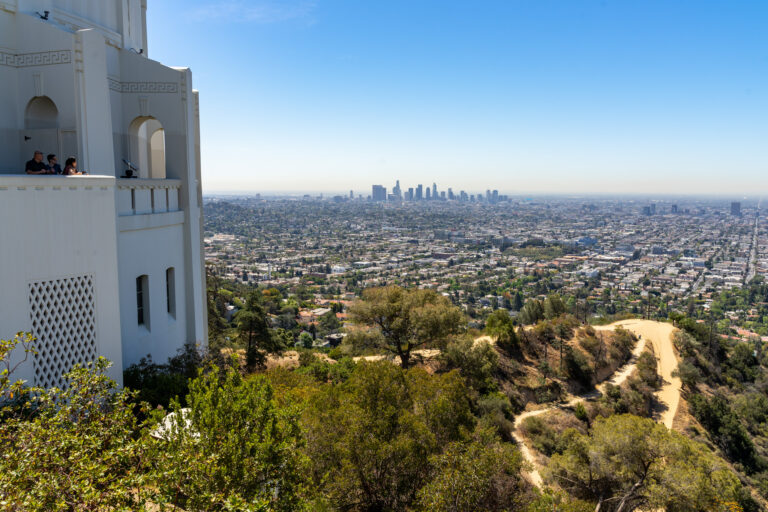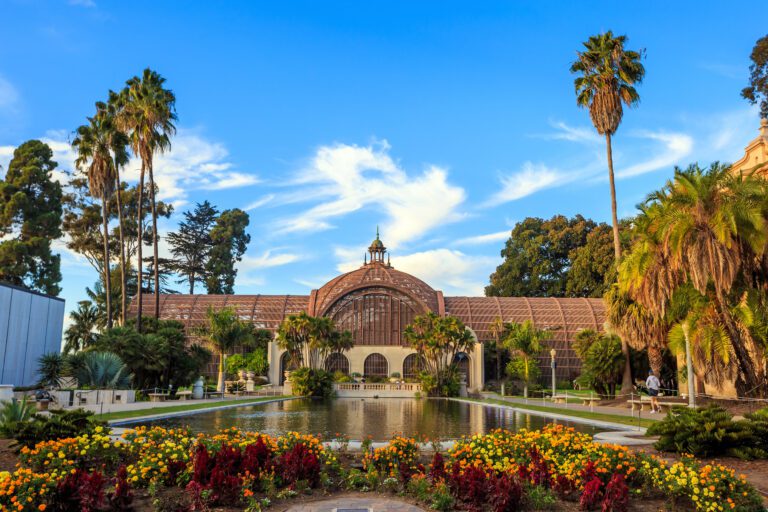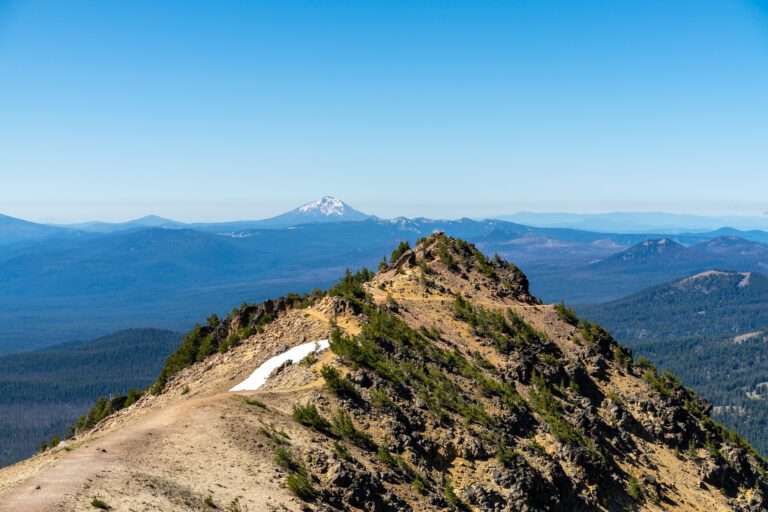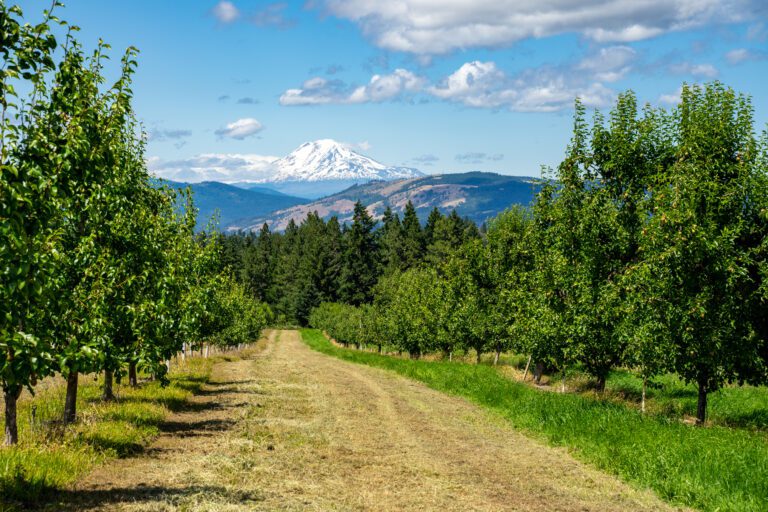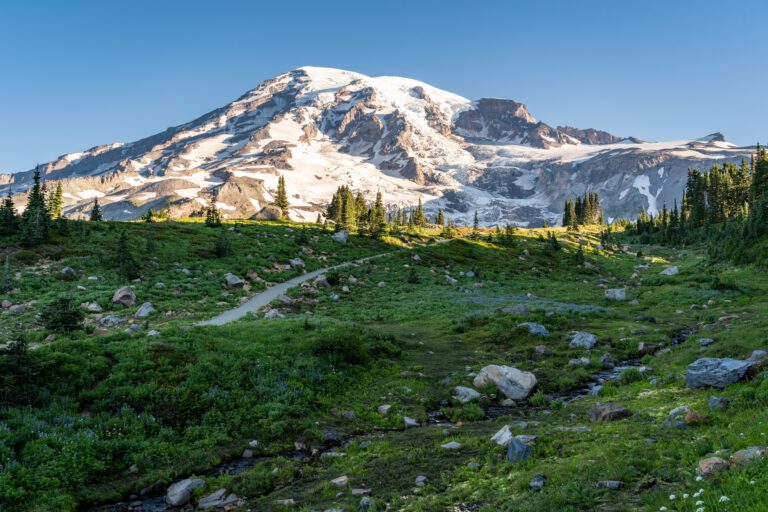How to Plan an Amazing Joshua Tree Itinerary: Weekend Guide
Joshua Tree National Park is, in my opinion, one of the absolute coolest US national parks. While I’ll never say no to beautiful lakes, tall mountains, and lush forests, there’s something incredibly special about spending some time among the Joshua trees in the otherworldly desert landscape. The area around the park is also worth checking out, with impressive restaurants and some unique and super funky gems.
If you’ll be making the trek out to Joshua Tree National Park, I’m here to help you plan the perfect visit.
I’ve lived in California my entire life, and now that I’ve settled in Los Angeles, I’ve spent a fair amount of time visiting this extraordinary national park and the area surrounding it.
Below, you’ll find a comprehensive Joshua Tree itinerary, as well as additional information to help you make the most of your time in the area!
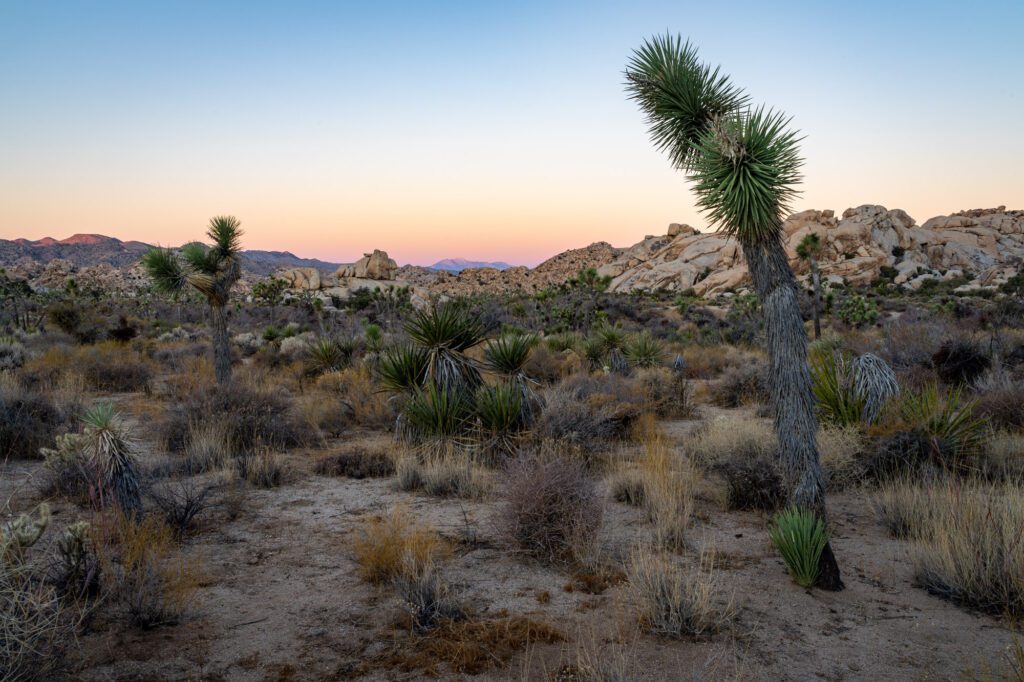
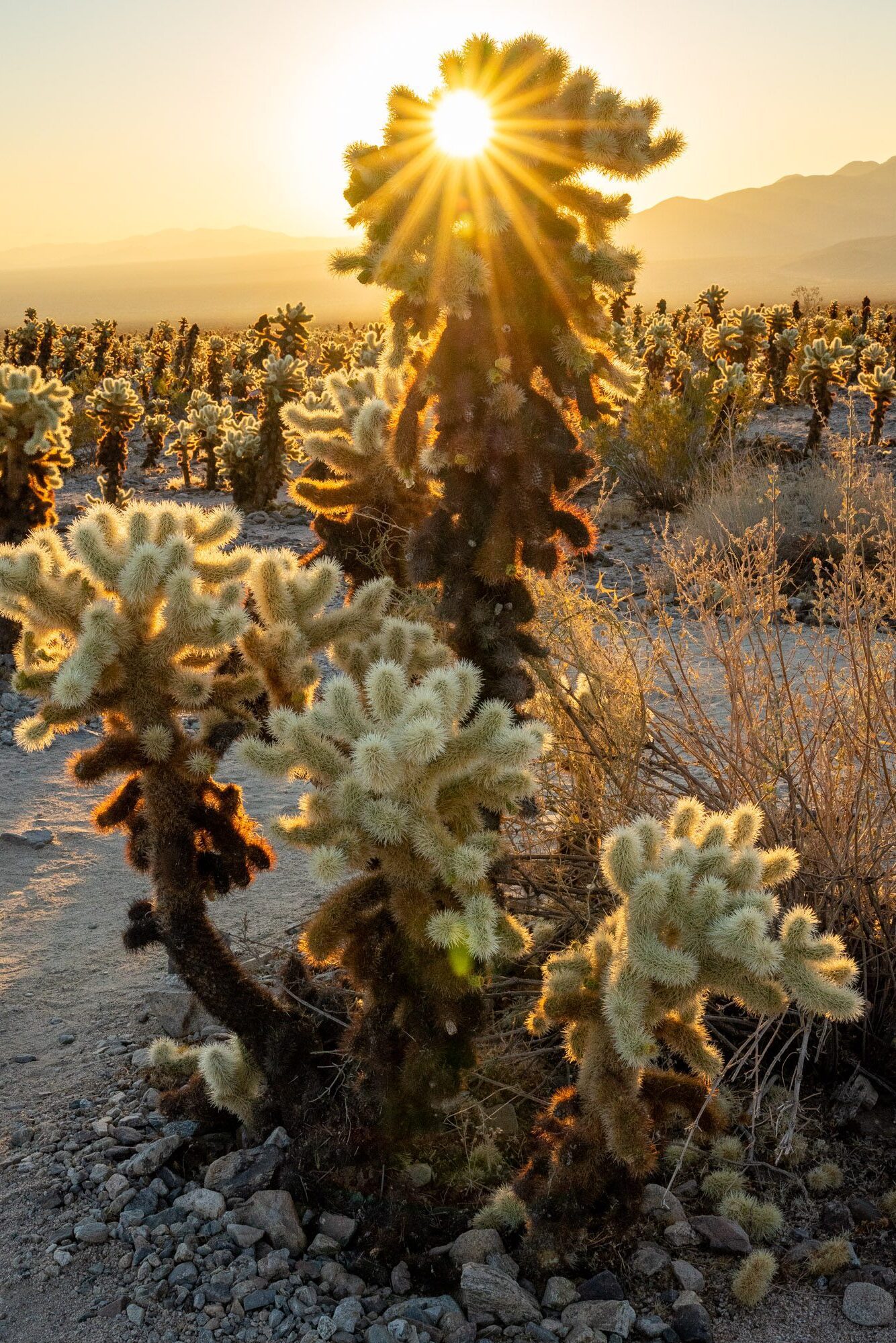
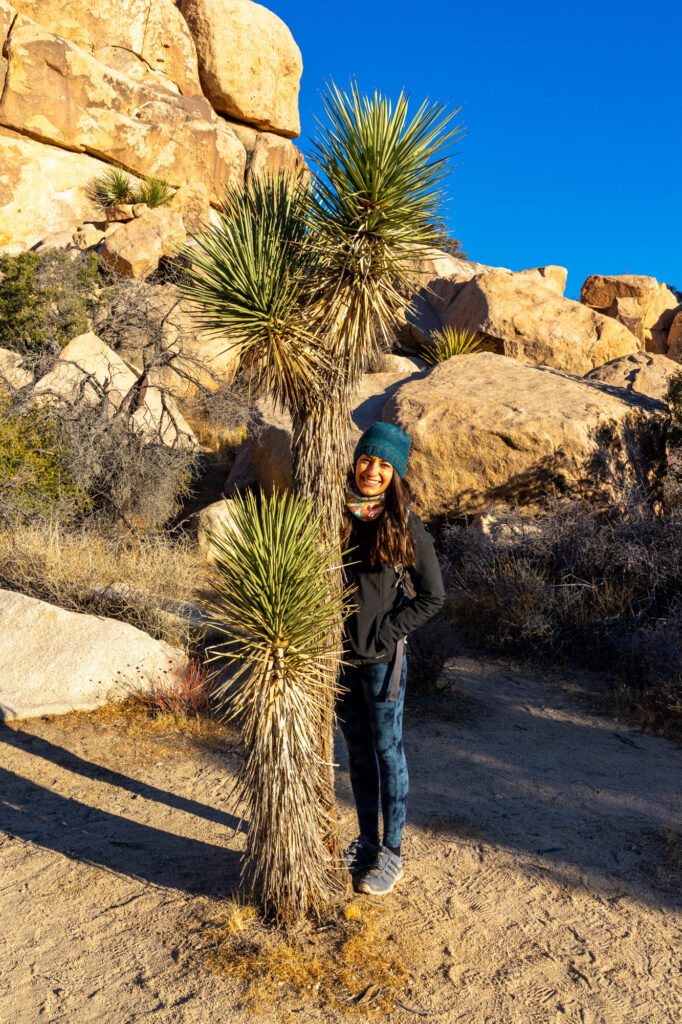
Disclaimer: Some of the links in this post, like hotel and vacation rental links, are affiliate links, meaning at no additional cost to you we make a little bit of money if you click through and book. That being said, we would absolutely never recommend something to you that we don’t stand behind 100%.
How Much Time Do You Need in Joshua Tree?
As far as seeing the actual park goes, two days is an ideal amount of time. I’ve spent the weekend in Joshua Tree National Park a few times, and it really gives you the time you need to get in a lot of hiking and have the full Joshua Tree experience.
You can absolutely add another day in the park if you’d like, but I wouldn’t say that it’s necessary. You’ll be doing a ton of hiking, so a third day might even be a bit too tiring!
For those that are also trying to spend some time in the town of Joshua Tree and the surrounding area, an extra day (or even just half a day) can definitely be helpful.
If you’re taking a weekend trip to Joshua Tree and want to explore both in and out of the park, consider dedicating half of one day outside of the park. The rest of your time can be spent checking out the park.
The Joshua Tree itinerary below is geared mostly towards exploring the park, with some meals in the town of Joshua Tree. You’ll find a few suggestions towards the end of this guide on additional things to do in the area if you have extra time.
Tips for Visiting Joshua Tree
There are a few main tips I want to highlight about visiting Joshua Tree.
- You’re going to have very little cell service. The park is fairly easy to navigate, but it’s a good idea to download the map of the area for offline use via Google Maps (here’s a guide on how to do that). Alternatively, grab an old-fashioned map!
- You’ll be doing a fair amount of driving, so make sure to head into the park each day with a full tank of gas. You won’t find any stations within the park, but there are plenty in the towns of Joshua Tree, Yucca Valley, and beyond.
- There is virtually no water or food available in the park, besides a few water stations at the very edge of the park. Come prepared and bring lots of food and water with you (more than you think you need!).
Where to Stay in Joshua Tree
When it comes to staying in Joshua Tree, you have two options: camping in the park, or staying at accommodations outside of the park.
We have a whole guide to figuring out where to stay in Joshua Tree with far more detail on each option.
Staying Outside of the Park
If you’re not into camping, your best (and only) bet is to stay at an accommodation outside of the park. Specifically, on the northern side of the park, which has more options compared to the southern end of the park.
There isn’t any sort of lodging in the park (other than camping, which we’ll get to), but there are some great hotels and house rentals in the town of Joshua Tree and the surrounding area (Twentynine Palms and Yucca Valley).
Here are a few hotels worth checking out:
- Joshua Tree Inn: This charming Spanish Colonial-style inn is another ideal option right in the town of Joshua Tree. There are 11 rooms available, each of which has a private patio. There is also a pool on-site.
- Sacred Sands: If you’re looking to enjoy a luxurious space after exploring the park, head to Sacred Sands, which is very conveniently located just over a mile away from the park entrance. Sacred Sands is small, with just one suite and one studio on the property. Each of these living spaces have private outdoor patios with outdoor showers and hot tubs, as well as a fire pit.
- Mojave Sands Motel: This chic Moroccan-influenced inn is located in the town of Joshua Tree, just a 10-minute drive from the park entrance. Mojave Sands has just three rooms and two suites. Each space has a private patio, an outdoor shower, and a record player.
If you’re looking for a budget-friendly stay, the Holiday Inn Express in Twentynine Palms is a solid option.
Camping Inside the Park
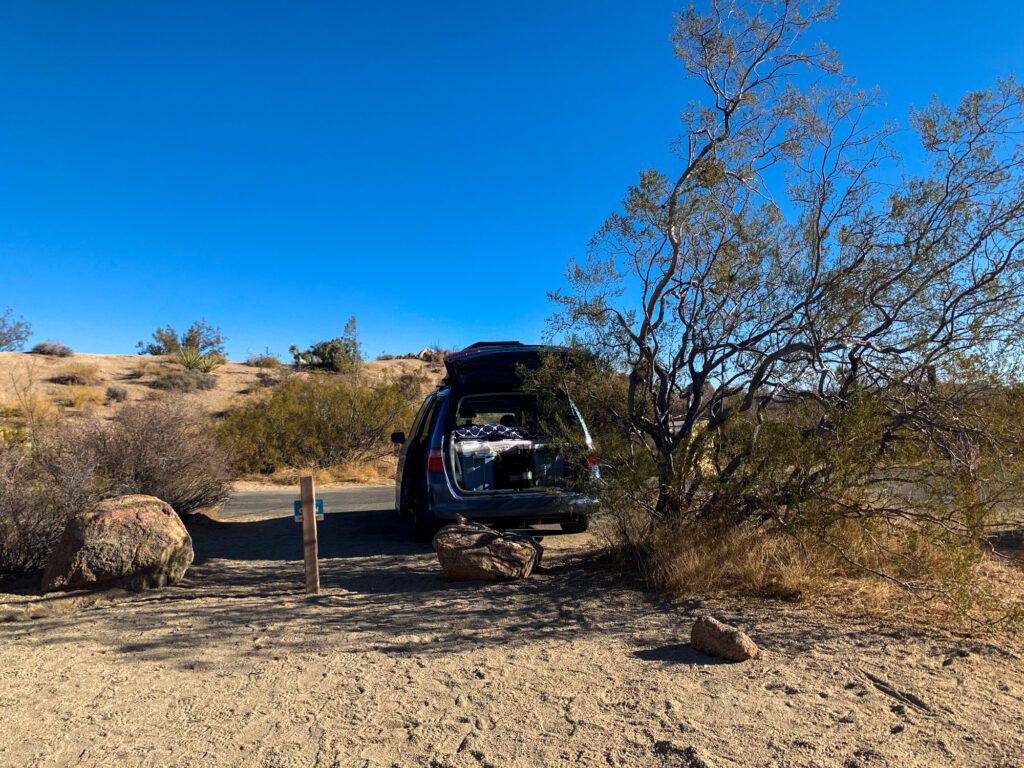
Camping in the park is a great way to experience Joshua Tree, as there are some really cool spots where you get to set up camp amidst the giant boulders.
If you’re a sunrise chaser, you also have the benefit of getting amazing sunrise views right outside of your tent. I’ve seen some of the most beautiful sunrises ever at Joshua Tree!
There are approximately 500 campsites in Joshua Tree, which are spread out over eight campgrounds. Six of these campgrounds require reservations, while the other three are first-come, first-serve. Keep in mind that many of the campgrounds don’t have water sources, so you’ll need to bring your own water into the park.
If you’re planning on reserving a campsite, I’d recommend making your booking as soon as you possibly can. Weekends and holidays can fill up months in advance (especially October through May), as can any day during the spring season. Reservations open up six months in advance.
If you plan on trying to get a first-come, first-serve spot, you’ll have the best luck if you come earlier in the week, especially around holidays and during the spring.
Per the National Park Service, these sites are typically full every weekend from September through May, and on most weeknights from February through May.
You can check out the National Park Service website for a full guide to all of the camping options within the park. I would recommend only booking at Black Rock, Cottonwood, or Indian Cove as a last resort, as all of these are pretty far from the main spots in the park.
With Black Rock and Indian Cove, you’d actually still have to drive through one of the main entrances to explore the best hikes in Joshua Tree and other spots in the park, which can add a lot of travel time.
Here are a few of the best campgrounds worth considering for your visit:
- Jumbo Rocks Campground (Reservations Required): Jumbo Rocks is one of the most sought out campgrounds, as it has incredibly cool scenery and is centrally located. There are 124 sites available, and the fee is $20 per night. Heads up: there isn’t a water source at Jumbo Rocks.
- Hidden Valley Campground (First-Come, First-Serve): This is another super popular campground. Like Jumbo Rocks, the boulder-surrounded setting can’t be beat, and it’s very central. There are 44 sites, and it will cost you $15 per night. Keep in mind that there isn’t a water source at Hidden Valley.
- Ryan Campground (Reservations Required): Ryan is another excellent centrally located campground with beautiful views and giant boulders. There are 31 sites, and it will cost you $20 a night. Ryan doesn’t have a water source.
How to Spend a Weekend in Joshua Tree: A Complete Itinerary
Let’s talk about spending 2 days in Joshua Tree National Park!
With this itinerary, you’ll be doing plenty of hiking and exploring outdoors. On both days, be sure to bring lunch, water, sunscreen, and plenty of snacks with you, and be prepared for a full day of adventuring!
Day 1: Explore the Park, Hike, and Enjoy the Sunset
On day one of your two day Joshua Tree itinerary, you’ll spend time in some of the most iconic spots in the park, including Skull Rock, Arch Rock, and Cholla Cactus Garden.
Explore Jumbo Rocks
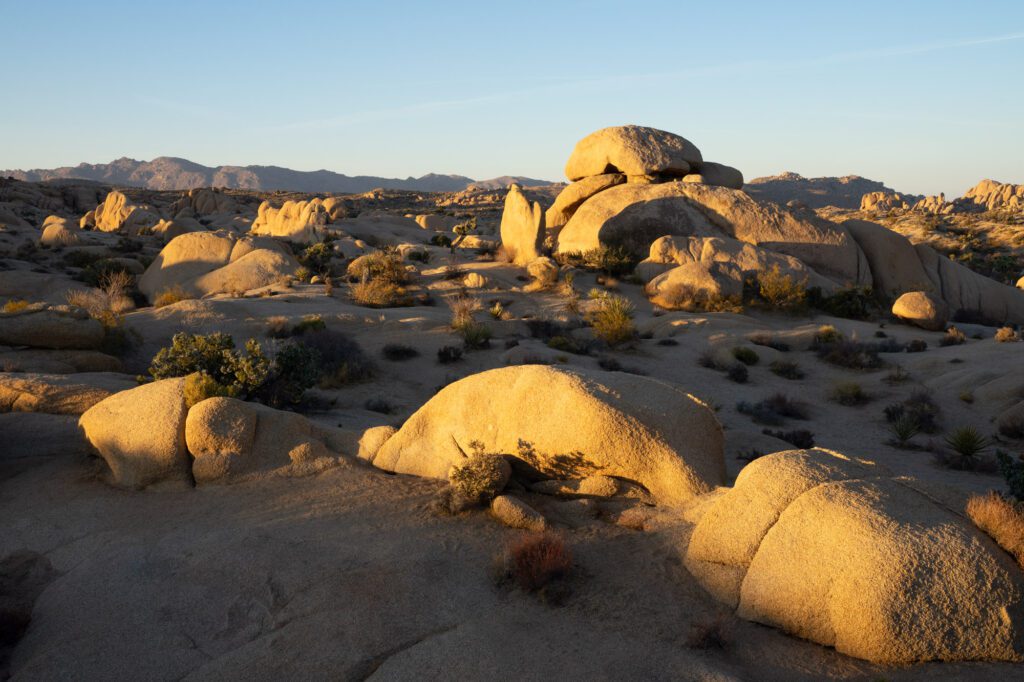
First up is Jumbo Rocks, which is located about 22 miles from the town of Joshua Tree (about a 35-minute drive). Even if you aren’t camping at Jumbo Rocks Campground, you can still check out the area!
This campground (and the area surrounding it) is popular for its insanely massive sculpted rock formations. Many of them are super easy to climb up, so you can get amazing views of the surrounding area. This is an absolute must when you’re at Jumbo Rocks, so be ready to scramble and explore.
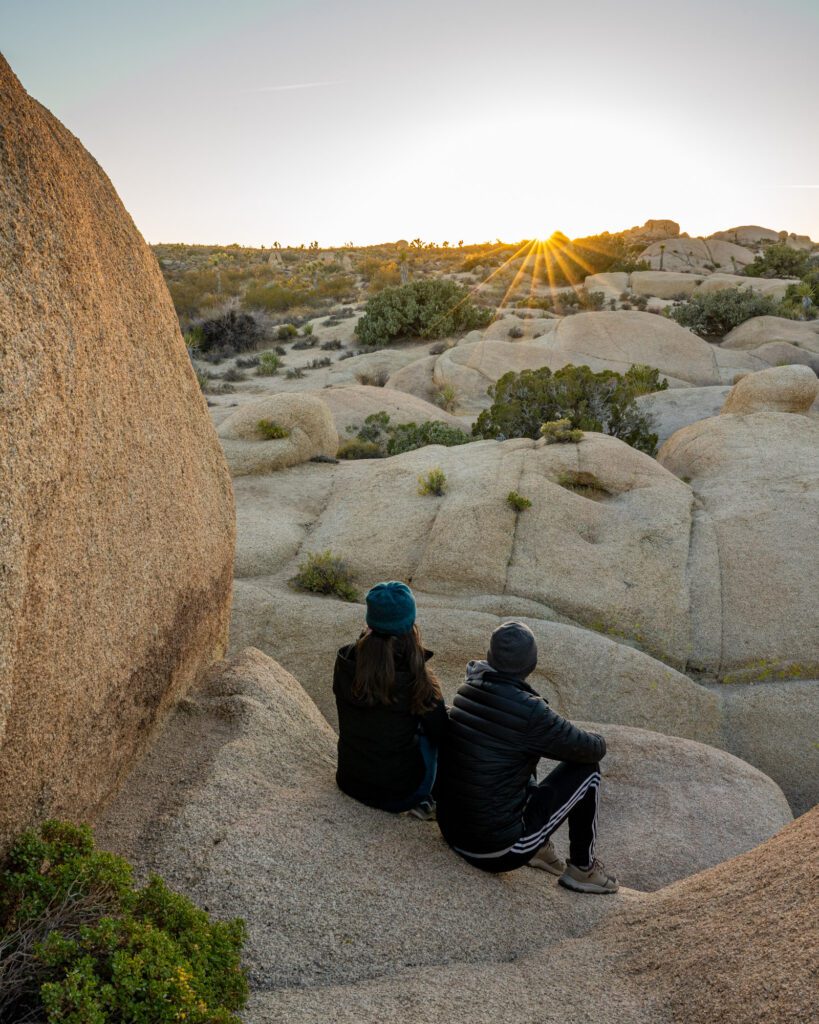
If you’d like to follow a set path, there is an easy loop trail that is just under a mile long that goes around the campground. However, in my opinion, I think it’s more fun to just walk around and explore whatever areas look cool to you. There are walking paths on both sides of Park Boulevard leading to very cool (and very giant) rocks.
Last time I visited this spot, I found that the collection of rock formations on the opposite side of Park Boulevard from Jumbo Rocks Campground was much less crowded. I’d suggest heading over there to get your Jumbo Rocks fix – there’s a clear walking path entrance directly across the street from the road that leads into the campground.
It goes without saying, but stay aware of where the road (and your car) is as you’re going out and exploring. That said, these rocks are fairly confined to one area, so it’s easy to find your way back.
Heads up: You’ll be street parking here. There are plenty of spaces on either side of the road.
Check Out Skull Rock
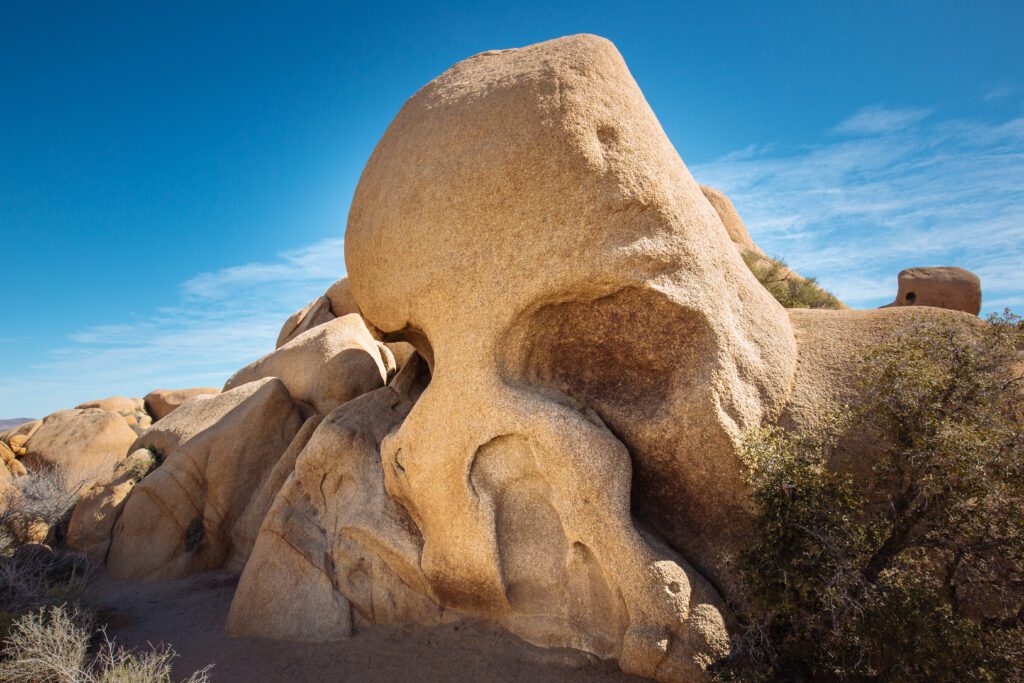
After enjoying the beauty of Jumbo Rocks, you’ll make a quick stop by Skull Rock, which is a little over half a mile down the road. Skull Rock (which is, unsurprisingly, a giant rock that looks like a skull) is located right off of Park Boulevard, and is easily accessed via a super short walking path.
It got its appearance as water accumulated on the rock, slowly eroding it until two hollowed-out “eyes” were formed.
This is a very popular spot, especially since it’s so easy to access from the road. Keep that in mind and don’t be surprised by the crowds (and if no one is there when you visit, consider yourself lucky!).
You have two options for getting to Skull Rock, the first being just driving down the road and re-parking on the street in the area. The second is hiking from Jumbo Rocks Campground directly to the rock.
This trail starts near the Jumbo Rocks Amphitheater, and is about half a mile (keeping in mind that you’ll need to either hike back or walk along the road to get to your car). Y
ou can look at this longer trail for reference – you’d be hiking along the section titled “Skull Rock Nature Trail”. While this trail is nice, remember that you’ll be doing a lot more walking today – you may want to save your energy and just drive!
Hike the Split Rock Loop Trail
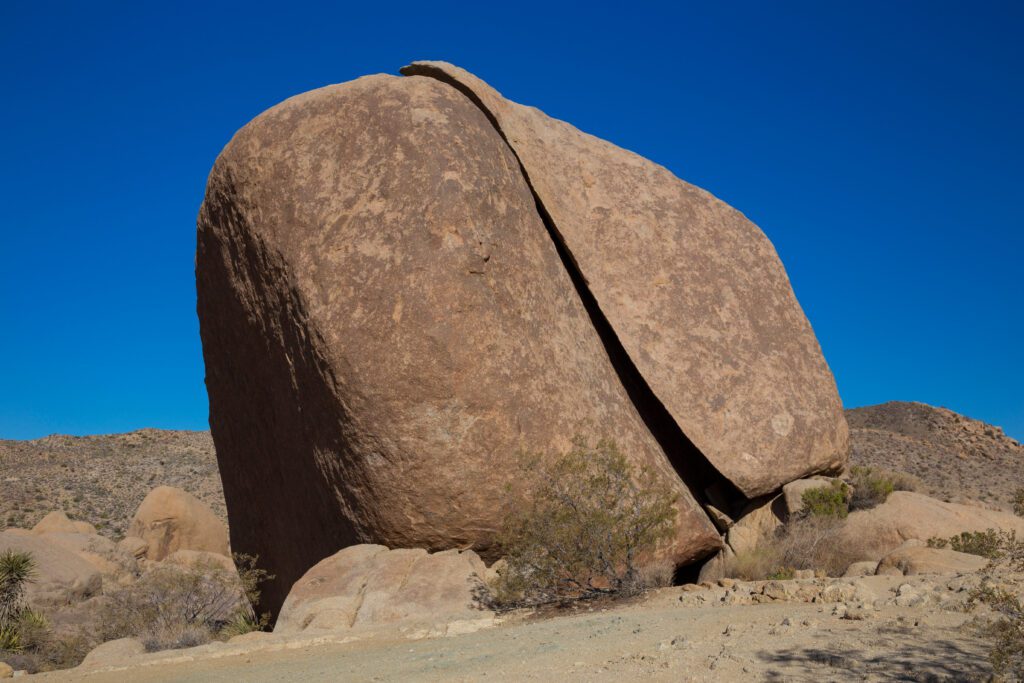
Next up is Split Rock Loop Trail, which is just about another mile down the road from Skull Rock. There are a few parking spots by the trailhead, but if they are all taken, you may need to street park on Park Boulevard, and then walk half a mile down Split Rock Road to the trail.
Split Rock Loop Trail is an easy 2.5-mile trail with a 275-foot elevation gain. As you hike through the area, you’ll pass by plenty of cacti, joshua trees, and maybe even some wildflowers, depending on the season. Of course, you’ll see a variety of cool rock formations, as well.
There’s a small picnic area by the trailhead where you can stop and eat your lunch before or after hiking. That said, I’d recommend stopping to eat on the trail instead, as you’ll have much better views (and won’t be right by the parking lot). Since there are so many large rock formations, you’ll find some perfect shaded spots to stop and eat lunch.
One note: This trail is sometimes hard to follow, as it isn’t always clearly marked. If you have an AllTrails Pro account, I suggest downloading the map for offline use so that you can refer to it. That said, I still managed the first time I hiked this trail without using AllTrails – you just need to keep your eyes peeled!
Hike Arch Rock Nature Trail
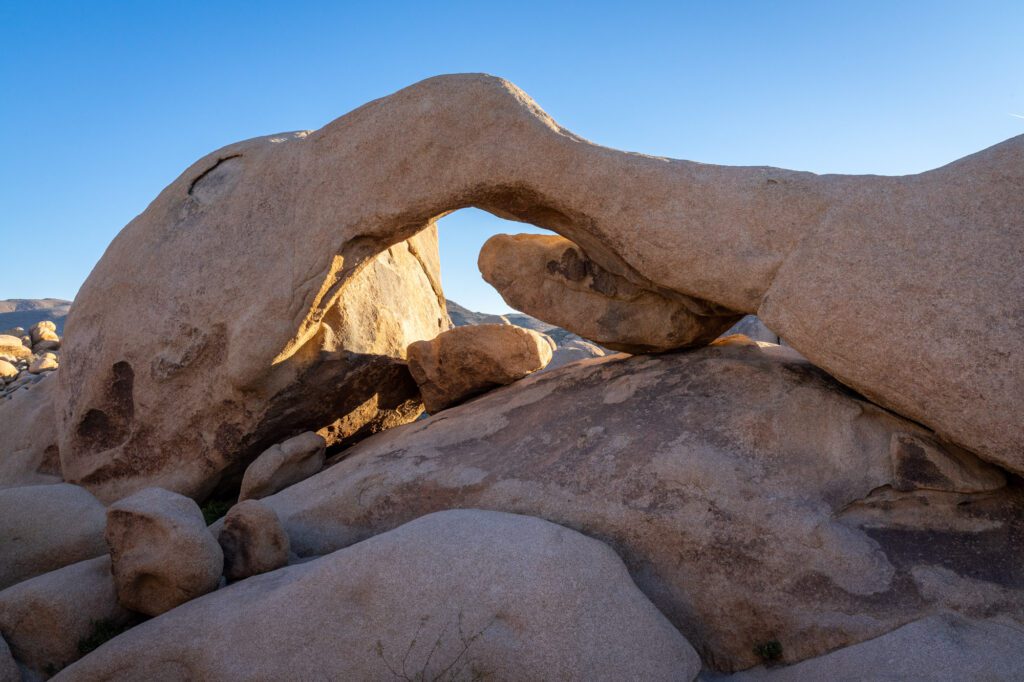
Next, it’s time for another hike at Arch Rock Nature Trail, an easy trail that is a 10-minute drive from the Split Rock Loop Trail parking lot. The parking situation is a bit odd, but it’s clear once you look at the map linked above.
You’ll park at a lot on the opposite side of Pinto Basin Road from Arch Rock. You’ll see the trailhead at the parking lot. Start hiking on that trail for less than a quarter of a mile until you hit the road. Cross the road, and then continue following the trail.
You’ll follow the out and back trail, which leads you to a small loop trail near a dense collection of rock formations. This is where Arch Rock is located. Typically, there are people in line to take their photos by the rock, so you may need to wait a bit once you’re there.
The full trail from the parking lot is 1.4-miles long, but there are a lot of cool spots off the small loop that are worth exploring, so it’ll likely be a bit longer. While the trail itself is easy, if you choose to check out the areas off the main trail, you may need to do some easy climbing over some rocks – so be sure you’re wearing the right shoes!
Enjoy the Sunset at Cholla Cactus Garden
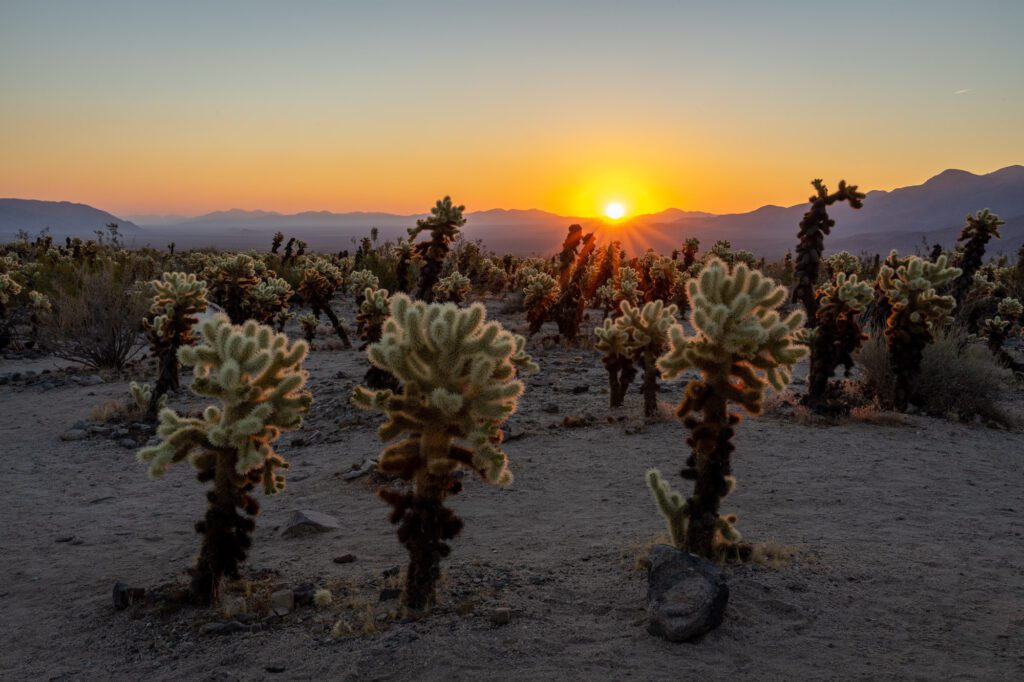
The final stop of the day is Cholla Cactus Garden, which is just under 8 miles down the road from the Arch Rock parking lot (about a 10-minute drive). This space is densely populated with cholla cacti, which are native to the US southwest and northern Mexico.
Cholla cacti are especially gorgeous during the hour or so leading up to sunset, as their almost translucent needles glow in the sun. Depending on when you’re visiting, you may also see some desert flowers in bloom.
If you’re curious, you can check out this National Park Service guide about what flowers and plants are found in the area.
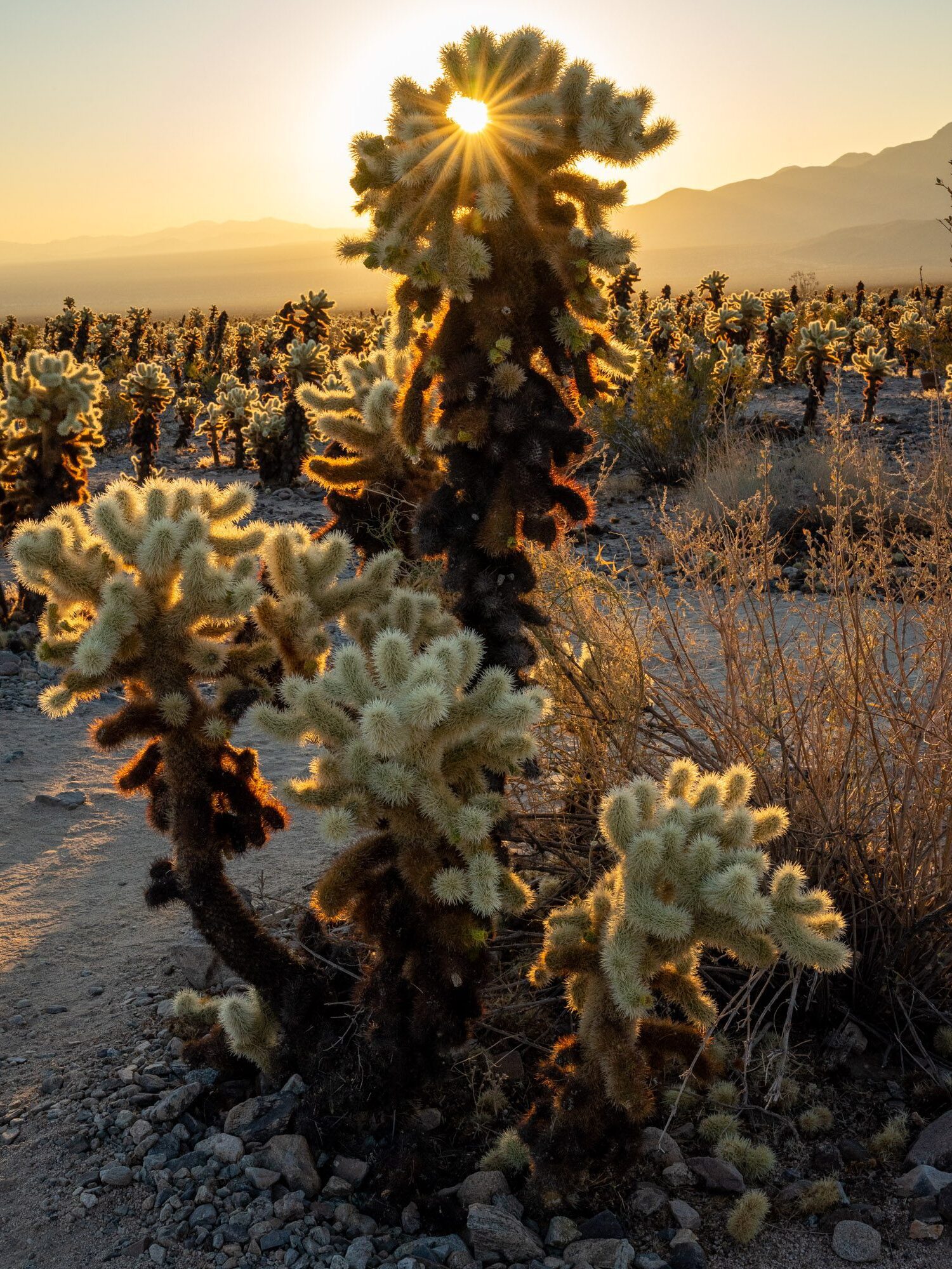
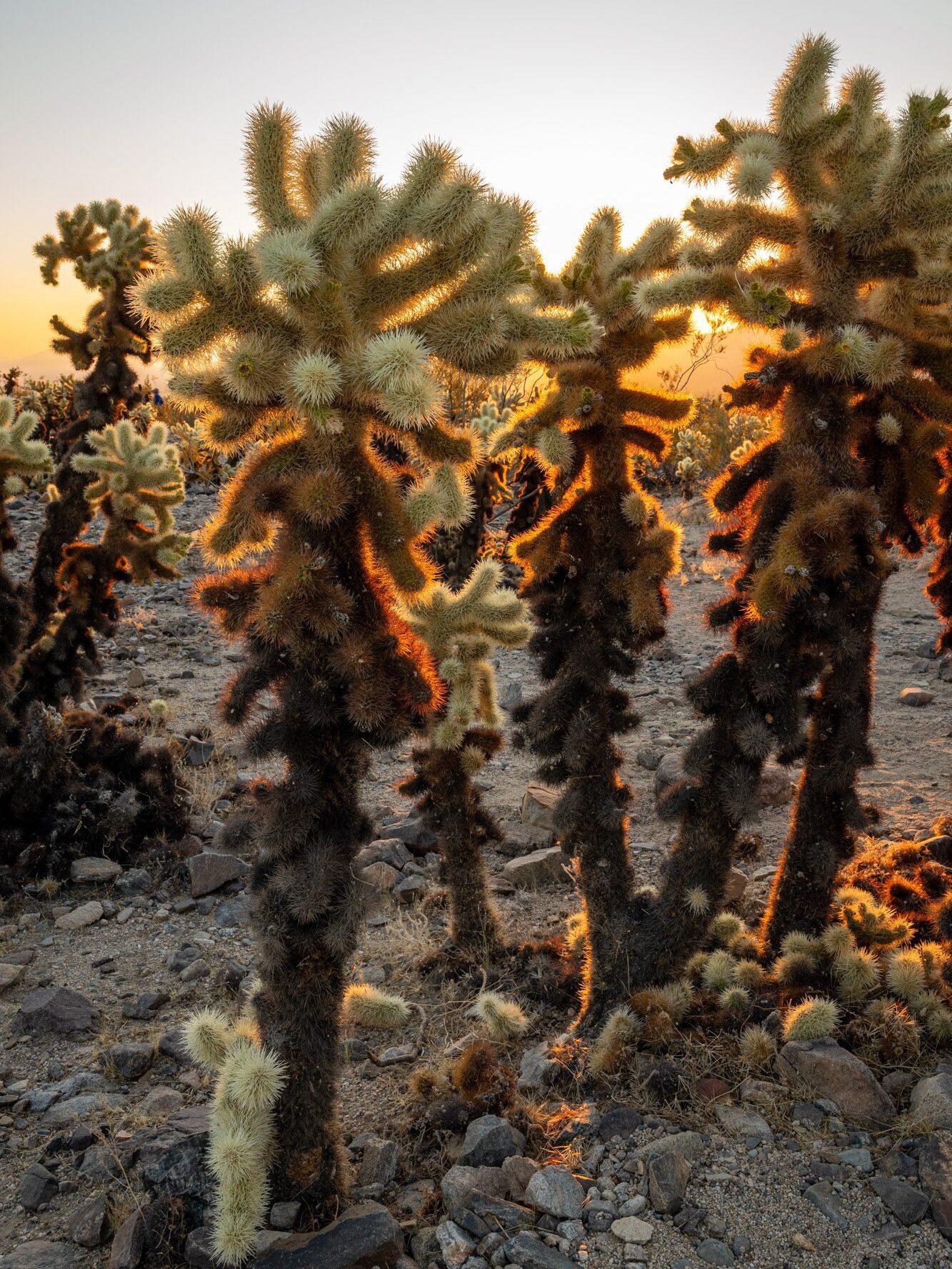
There is a short walking path around the garden that is a bit over a quarter-mile long. I highly recommend staying on this path. The cholla cacti are notoriously spikey and can easily latch onto your clothing or skin.
Some spikes do end up on the ground and can stick onto your shoes and ankles, so be cautious about where you’re stepping (unfortunately, I’m speaking from experience!).
Get Dinner in the Town of Joshua Tree
Nothing is better than a hearty meal after a day of being active! If you’ll be heading back into the town of Joshua Tree for the night, there are a few great places to grab dinner:
- Joshua Tree Saloon: This iconic old west-style bar and grill has been serving Joshua Tree visitors since 1984. Joshua Tree Saloon has burgers, steak, sandwiches, seafood, and more, as well as beer, wine, and cocktails. They also frequently have live music. Of the three options on this list, this one is open the latest, so it’s ideal if you spend a little extra time in the park.
- Crossroads Cafe: Crossroads serves delicious diner food that’s influenced by the southwest. You can order hamburgers (including a vegan option), sandwiches, quesadillas, tacos, salads, and more. They also offer wine and beer.
- Sam’s Indian Food and Pizza: This casual spot has something for everyone! Sam’s has a huge range of traditional Indian dishes, as well as your favorite classic pizzas. They also merge the two food categories to offer Indian-inspired pizzas, such as the Bombay pizza, which is made with masala sauce and chicken tikka.
Day 2: Ryan Mountain, Hall of Horrors, and Key’s View
On the second day of your two days in Joshua Tree, you’ll start the morning by grabbing coffee and breakfast in town. Next, you’ll make your way back into the park for more hiking and exploring!
If you don’t pack your own lunch to bring into the park, there are a couple of places in the town of Joshua Tree where you can purchase sandwiches and other items.
After you eat breakfast, I recommend stopping by one of these spots to get something to-go for later. You’ll find a few suggestions in the eating and drinking section towards the end of this guide.
Grab Coffee and Breakfast in Town
Kick off the day by fueling up in the town of Joshua Tree. If you’re a coffee drinker, you absolutely have to start your day with a cup of Joe from Joshua Tree Coffee Company, which is the best place to go for a high-quality cup of coffee. They have your classic coffee shop drinks, including lattes, mochas, flat whites, and cold brew.
Joshua Tree Coffee Company doesn’t have food, but there are a few great places to stop by for breakfast. Here are two spots in town that I really like:
- Natural Sisters Cafe: This cafe takes a natural and healthier approach to comfort food. It’s a fully vegetarian spot, with morning items including a veggie sausage and egg slider, a vegan breakfast wrap, biscuits and gravy, and breakfast bagel sandwiches. They also have delicious smoothies and juices, as well as coffee and tea drinks.
- Country Kitchen: If you are in more of a local diner mood, head to Country Kitchen, which has been serving the community since 1977. Country Kitchen offers everything you’d want from a breakfast diner, including pancakes, omelets, French toast, and breakfast burritos (including a vegan option).
You’ll have a pretty busy day, so be sure to get out as early as you can. All of these spots currently open at 7:00 am (but be sure to check their websites for the most up-to-date hours).
Hike the Ryan Mountain Trail
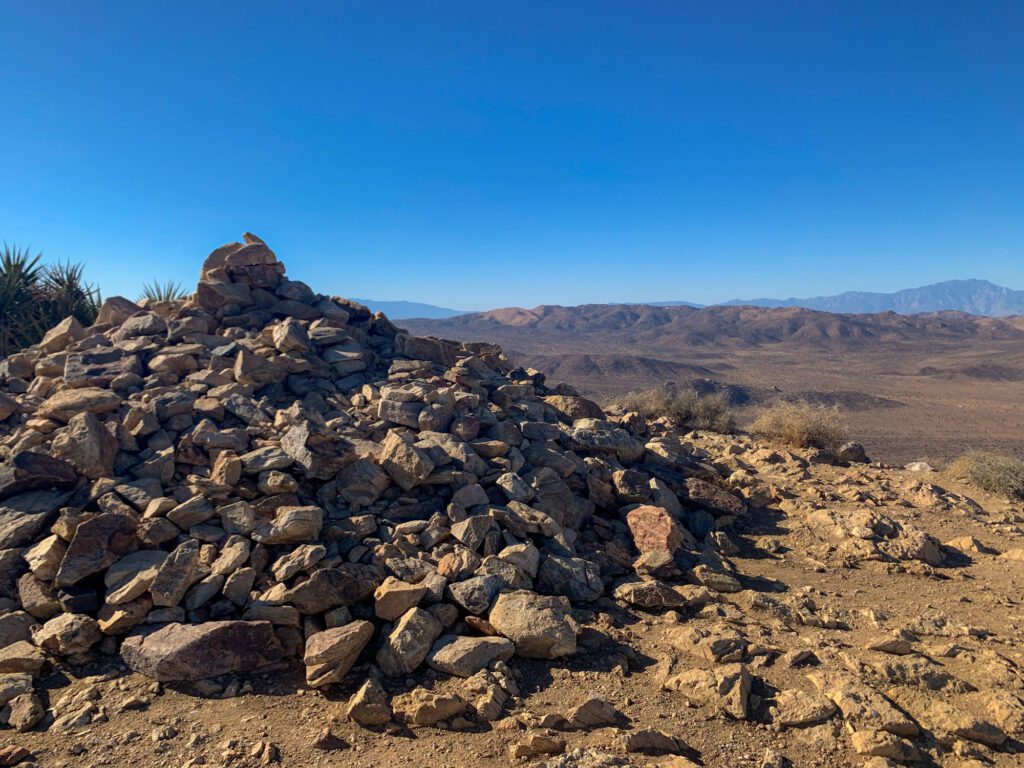
After breakfast, it’s time to drive into the park for the first hike of the day on Ryan Mountain Trail. The trailhead is about a half hour drive from the town of Joshua Tree, so you’ll have a moment to digest before you get moving. Parking is easy here, as there are plenty of spots right by the trailhead.
Ryan Mountain Trail is a 2.9-mile out-and-back trail that has an elevation gain of 1,062 feet. You’ll pass by Joshua trees and other desert plants before making your way to the peak, where you’ll get sweeping views of the park and beyond.
While this trail isn’t too hard, it is rated as moderate. You’ll be walking uphill the entire first half as you make your way to the peak, so it is definitely a workout.
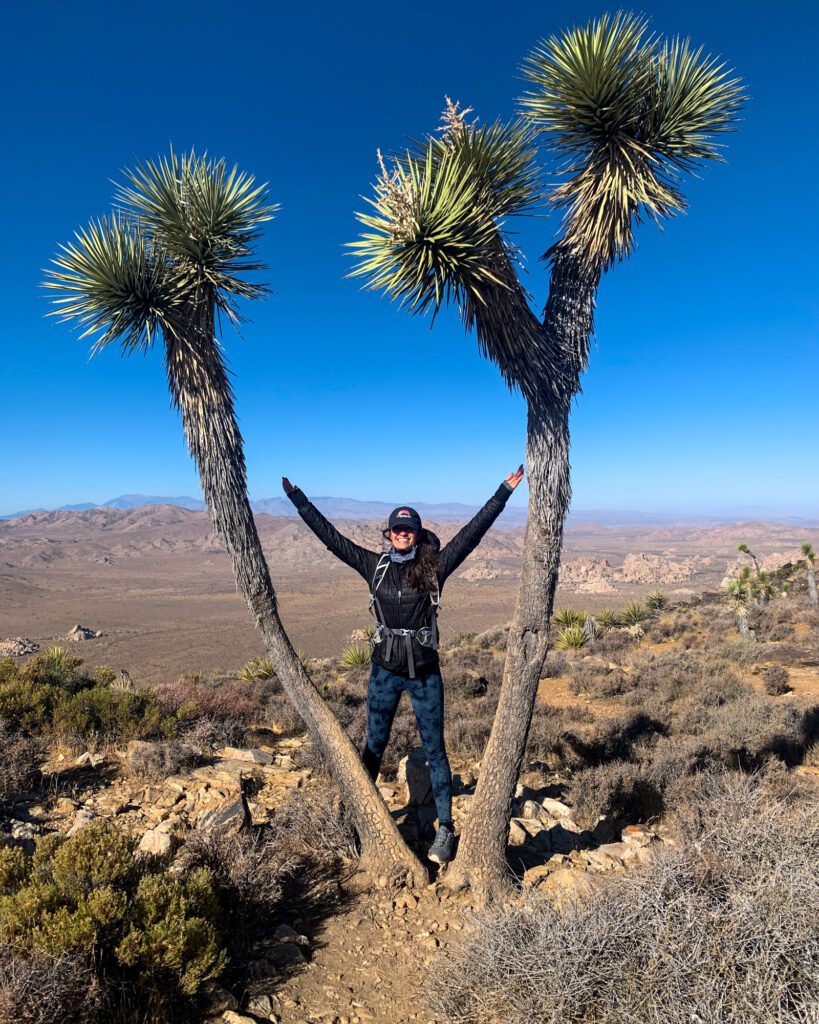
It’s a great hike, but if you’re worried about it being too tiring, I’d recommend skipping it and starting your day in the park with Hall of Horrors.
Keep in mind that you’ll be doing four other hikes on this day (all of which are easier and much shorter).
It’s also worth noting that you’ll end the day with a drive up to another high elevation viewpoint in the park, so you’ll still have a chance to get some beautiful panoramic views of the area.
Explore the Hall of Horrors
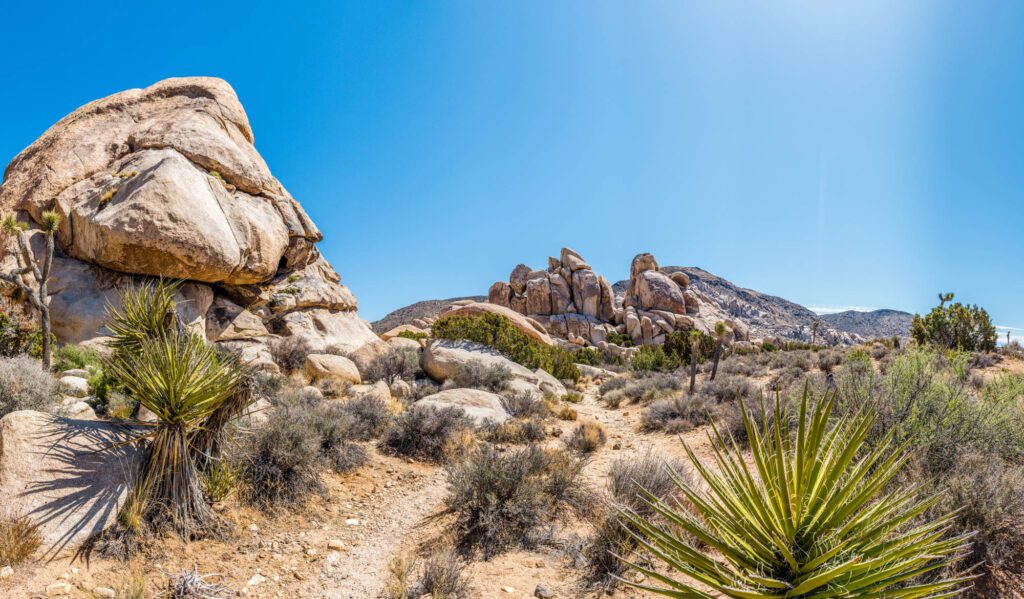
Next up is the Hall of Horrors, which is about three-quarters of a mile down the road. There are plenty of parking spots right in front. The main Hall of Horrors Loop Trail is just over half a mile long, and has basically no elevation gain. As you follow this easy loop, you’ll have amazing views of Joshua trees and clusters of giant boulders.
The actual Hall of Horrors is a slot canyon that’s super fun to walk through if you are up for it. It does require a bit of rock scrambling to get to, so if you decide to go for it, be sure to wear shoes with good traction. The loop trail doesn’t lead directly to this slot canyon, but you can get to it if you know where to look!
Getting to the Hall of Horrors
There are three larger clusters of rocks in this area: one to the left of the parking area, a larger one directly in front of the parking area, and then a slightly smaller one behind that.
The Hall of Horrors is located in the third rock cluster – the one furthest from the parking lot. The loop trail goes in between the largest rock cluster and the cluster where this slot canyon is located.
When you get to that point in the short hike (about halfway through the loop), you can explore off the main trail to try to find the Hall of Horrors.
If you look at the AllTrails map linked above, you’ll see where the Hall of Horrors is tagged. To get to this slot canyon, you’ll need to access it from the left of this cluster of rocks – there are a few short paths you can take to get there. The Hall of Horrors is located towards the front of this cluster, so start doing a bit of scrambling to find it.
If you aren’t able to find the Hall of Horrors, don’t sweat it. This is still a really cool and very scenic area to check out if you’re looking to do a bit of rock scrambling up some giant boulders!
Eat Lunch and then Hike at Hidden Valley Nature Trail
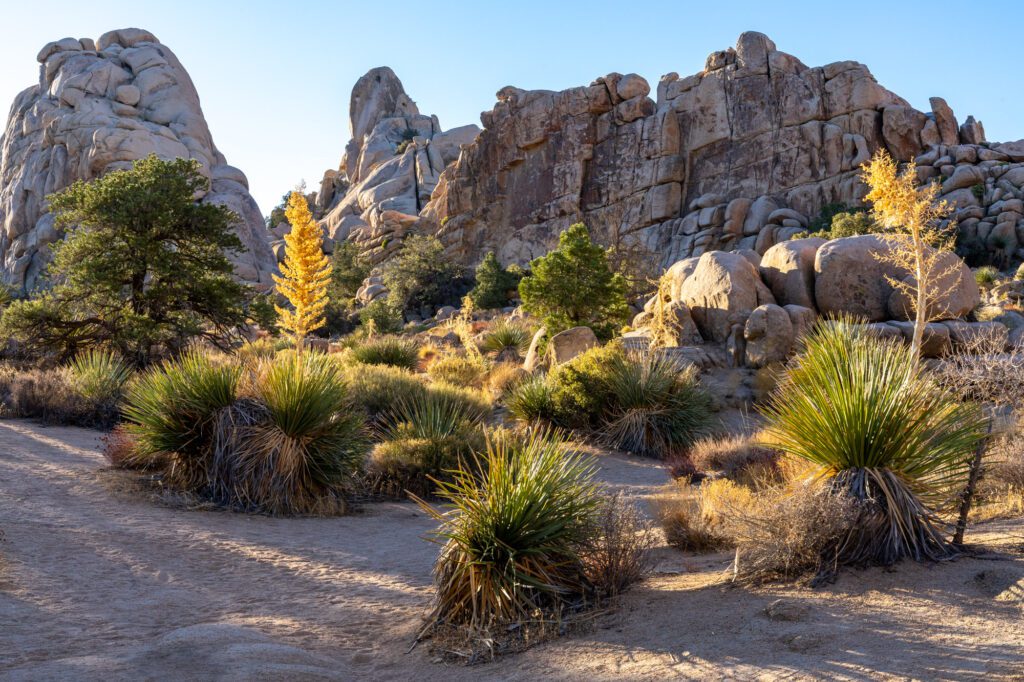
After exploring the Hall of Horrors, drive about 10 minutes down the road to the Hidden Valley Nature Trail.
This is another area with a ton of parking spots, so parking should be a breeze. Before going on your hike, give your feet a rest and enjoy some lunch. There are lots of tables tucked amidst the giant boulders all around the parking area, so you can easily find a nice spot to take a break and eat.
Once you’ve had lunch, it’s time to enjoy Hidden Valley Nature Trail, which is one of my absolute favorite hikes in Joshua Tree National Park. This loop trail is just 1-mile long, and has very little elevation gain.
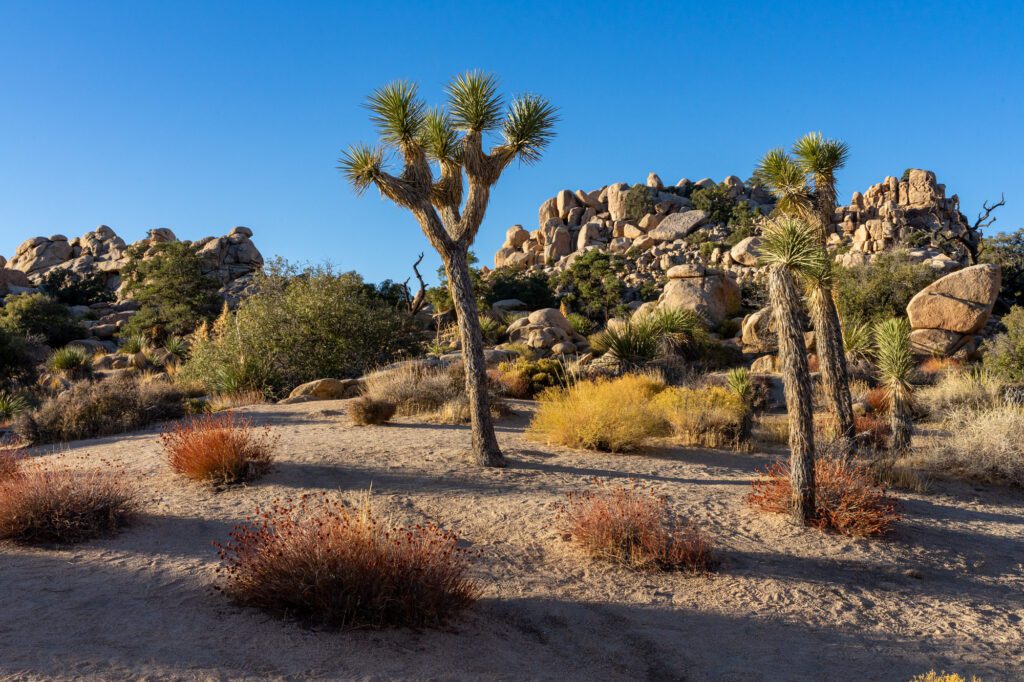
You’ll be in a valley surrounded by magnificent giant boulders basically the entire time, so you’ll have more than enough opportunities to get in even more easy rock scrambling if you’d like. You’ll also see plenty of cacti, Joshua trees, and other desert plants, as well as wildflowers if you’re there in the right season.
Hike Barker Dam Nature Trail & Wall Street Mill Trail
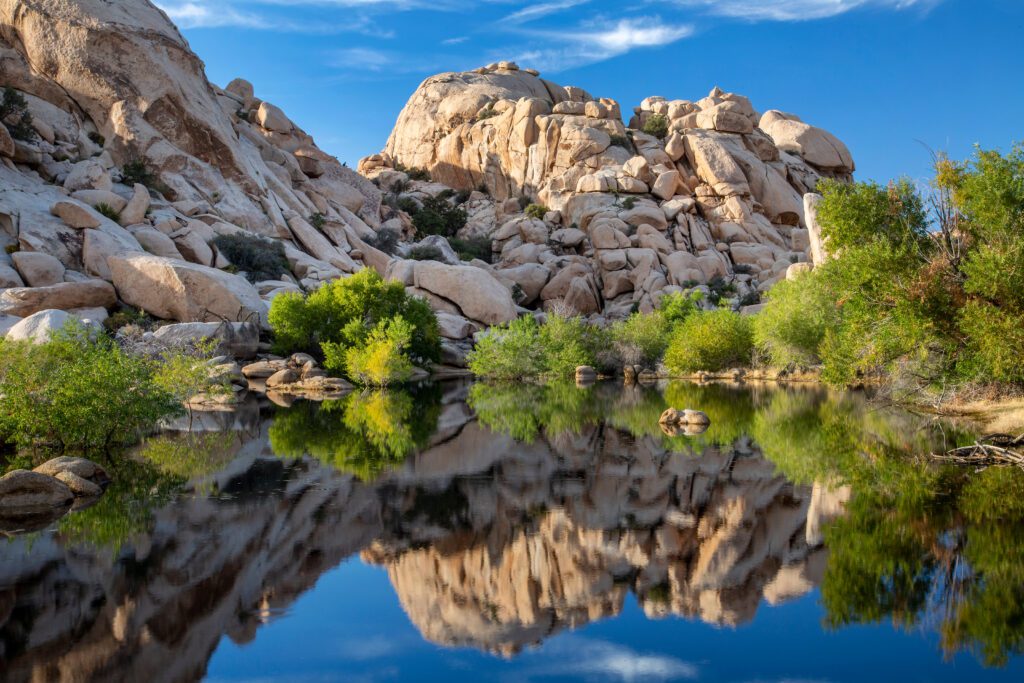
You’ll finish off your hiking for the day with two easy trails that are right next to each other. These trails are on the opposite side of Park Boulevard from Hidden Valley, about 2-miles down Barker Dam Road. There is a parking lot by the trailheads, but it does fill up quickly. You may need to park on the road and walk over.
First up is Barker Dam Nature Trail, a 1.1-mile loop trail. This trail has two particularly unique spots. The first is Barker Dam, which was built by cattlemen around 1900. There isn’t always water here, but it’s definitely a cool sight when there is. Bighorn sheep are known to hang out in the area, so keep your eyes peeled!
Here are some more photos of this area from a pre-sunrise hike.
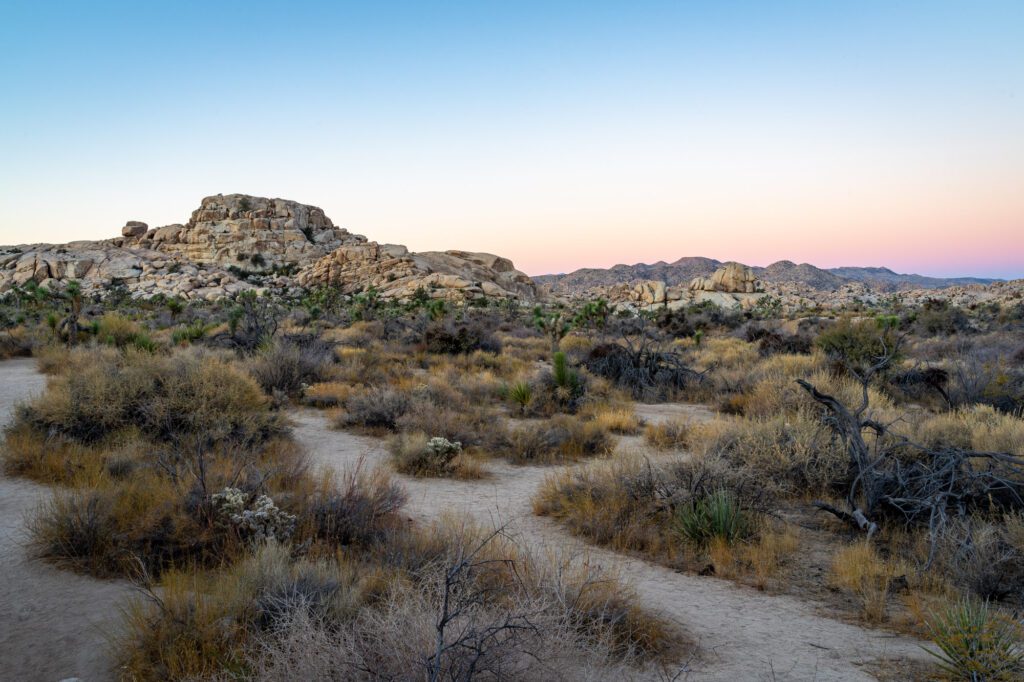
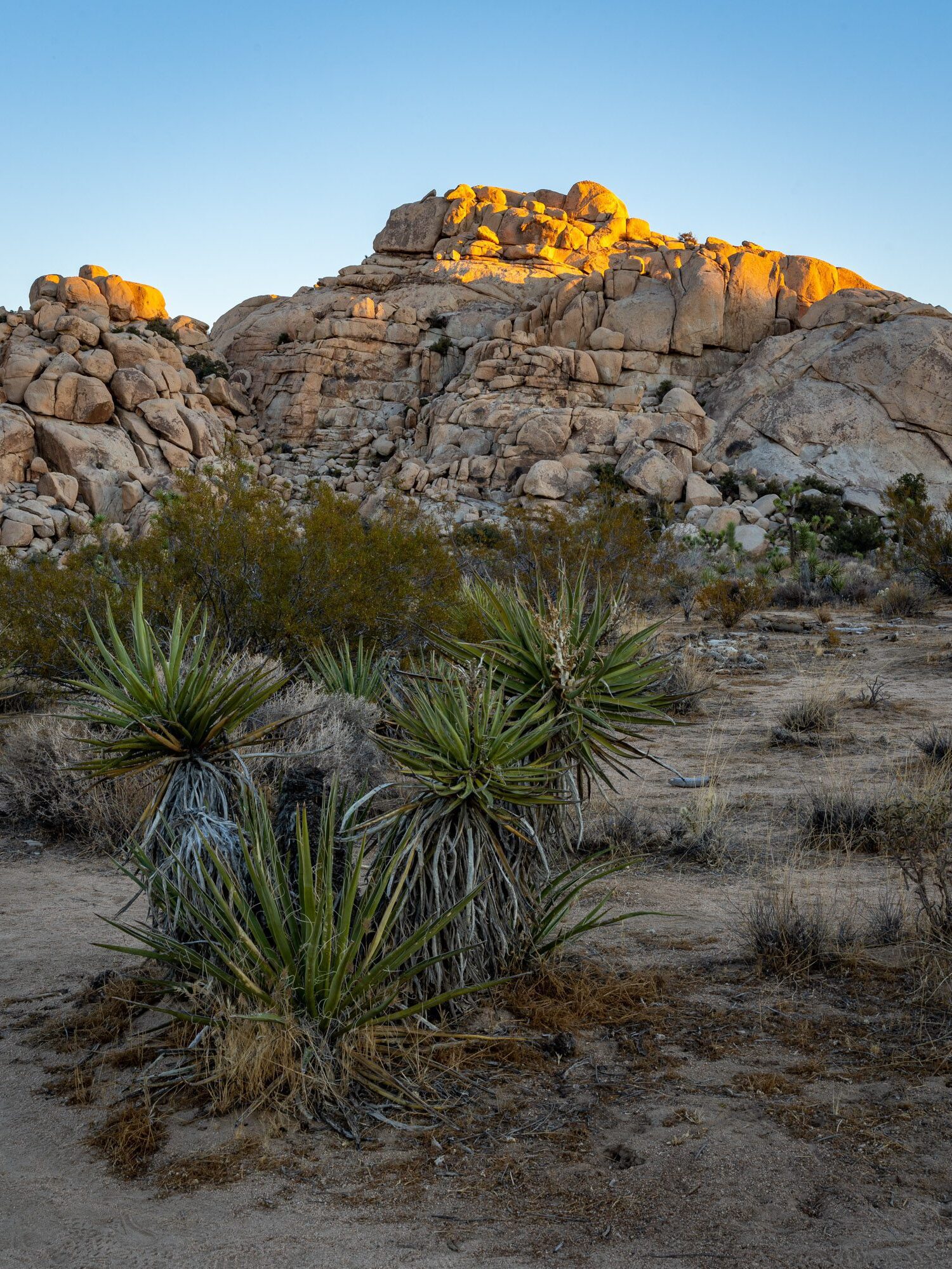
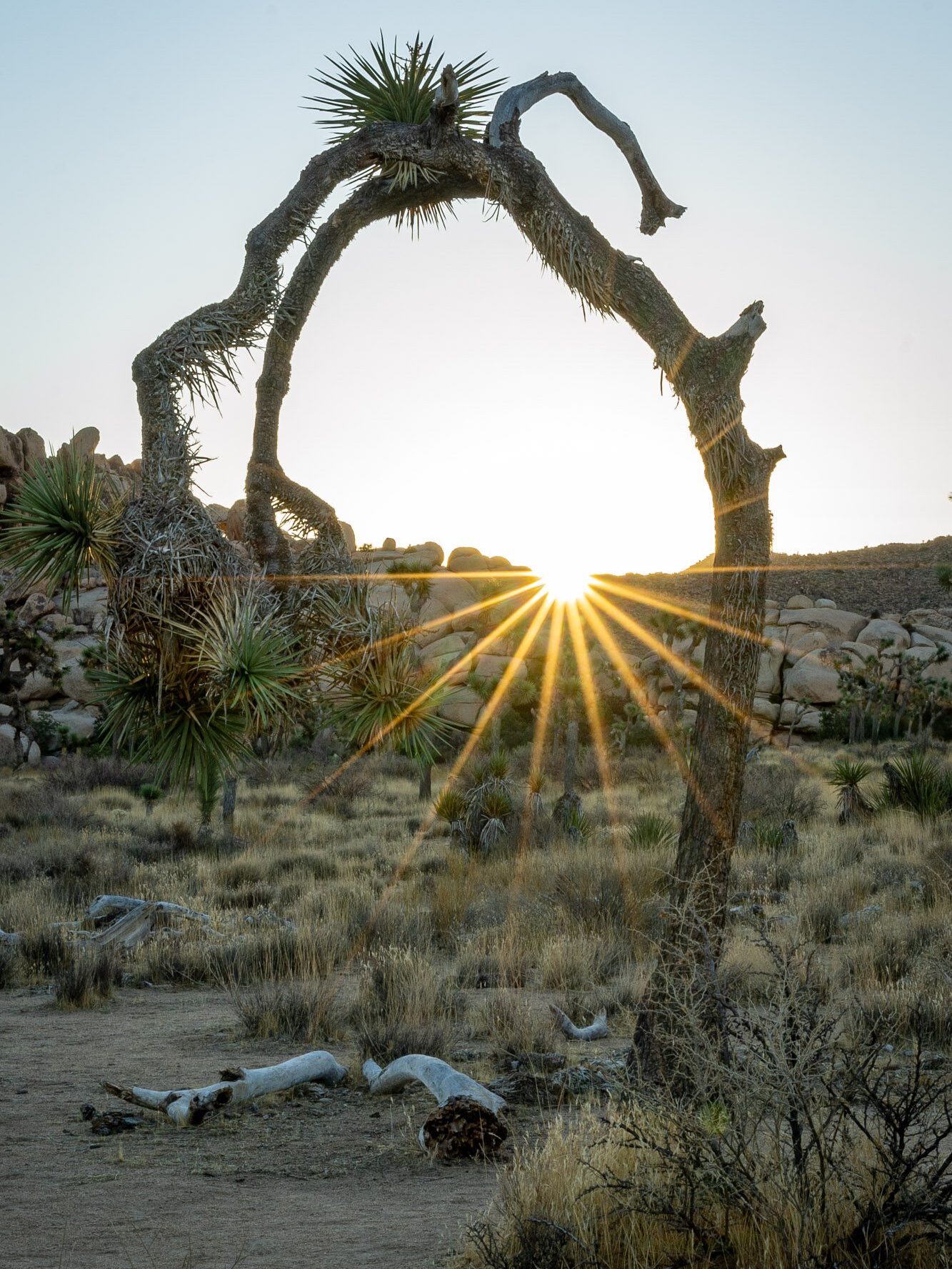
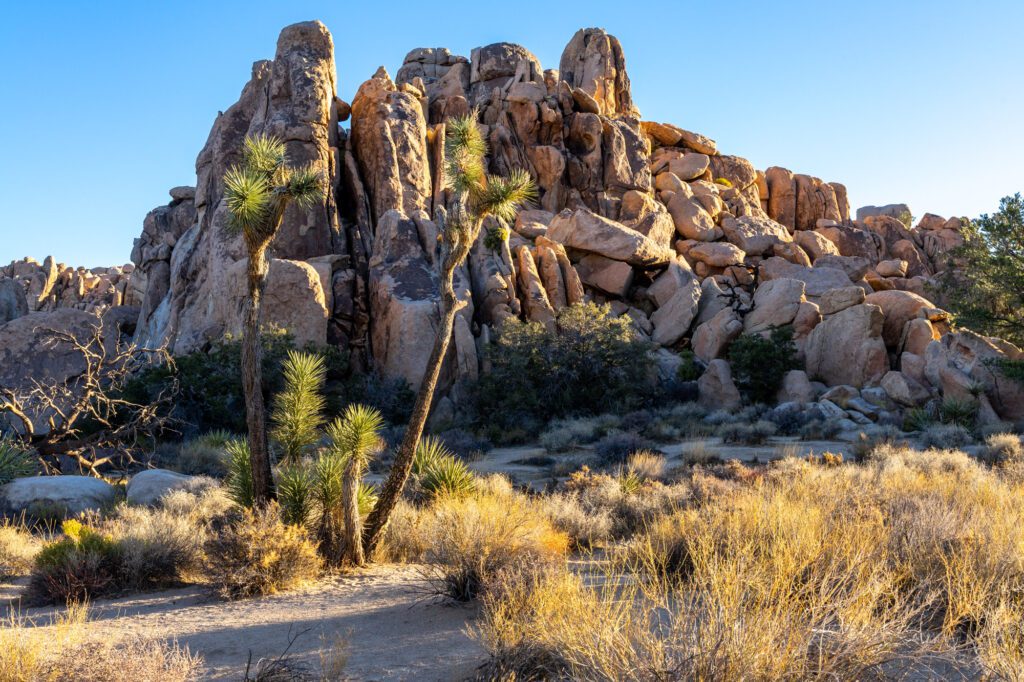
You’ll also pass by Native American petroglyphs on a large boulder. It’s fairly easy to pass by this spot when you’re hiking, so take note of where they are on the map and look out for the sign.
It should go without saying, but admire the petroglyphs from a distance, and don’t climb on the rock. You’ll still be able to get a close-up view of them while staying on the path.
After making your way back to the parking lot, you’ll check out the Wall Street Mill Trail. You’ll see a large sign just to the right of the Barker Dam trail sign leading you towards the trailhead.
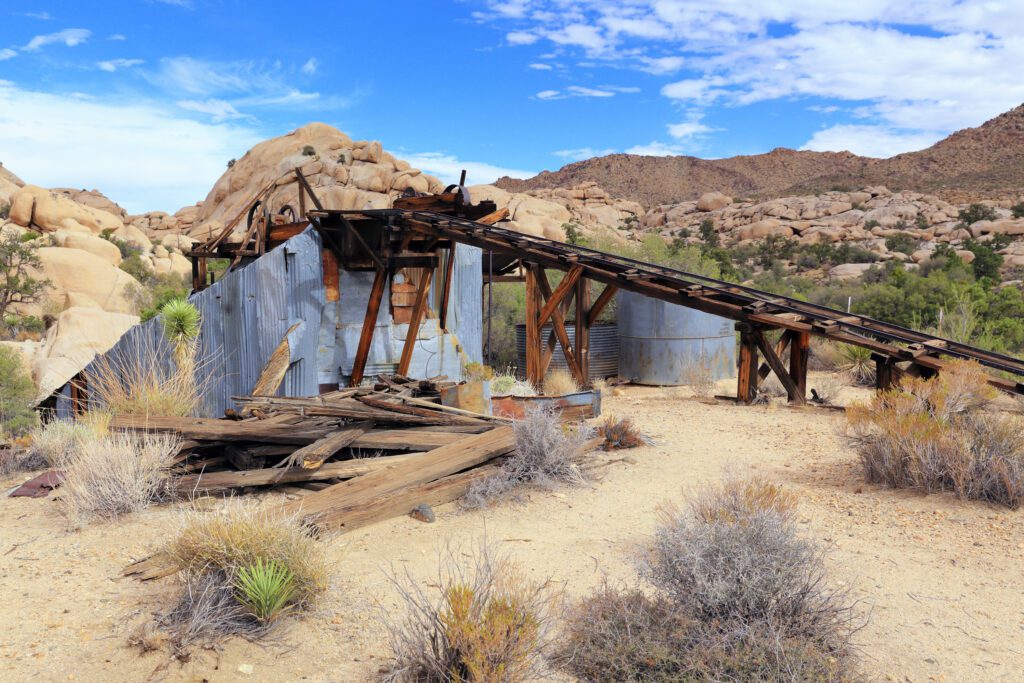
Wall Street Mill Trail is 2-miles long, and like Barker Dam, passes by some interesting historical sites that you won’t see in other parts of the park.
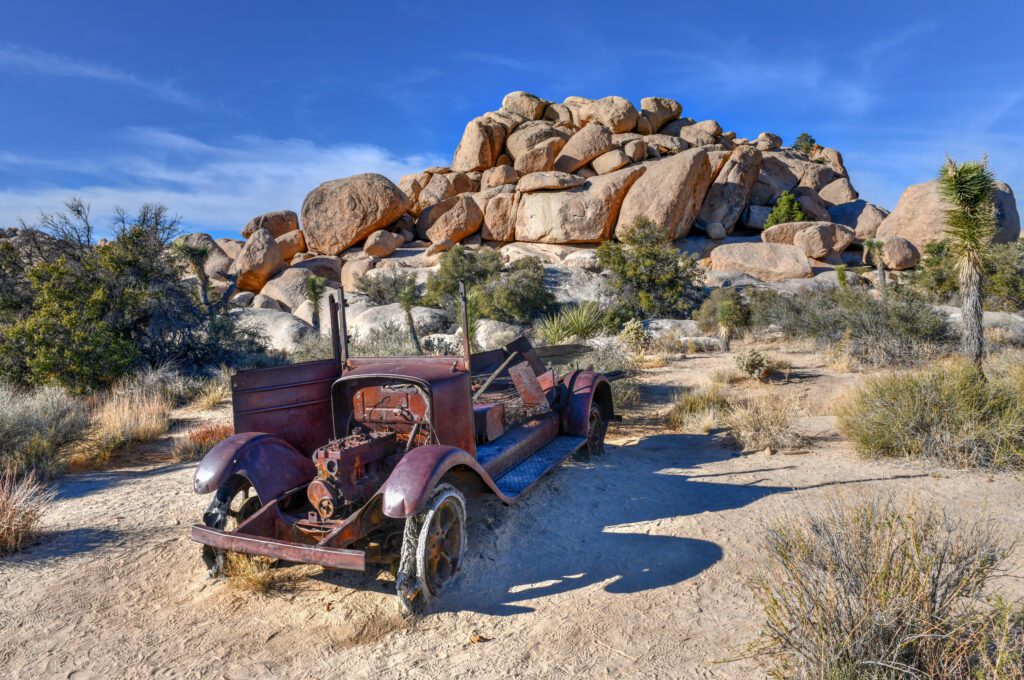
The main site – which is at the very end of the out-and-back trail – is the ruins of Wall Street Mill, which dates back to 1933. This two-stamp gold ore crushing mill operated from around 1930 to the mid 1960s. As you follow the trail, you’ll also pass by a windmill and water pump, an abandoned rusty car, and what is left of an old house.
Take in the Scenery at Keys View
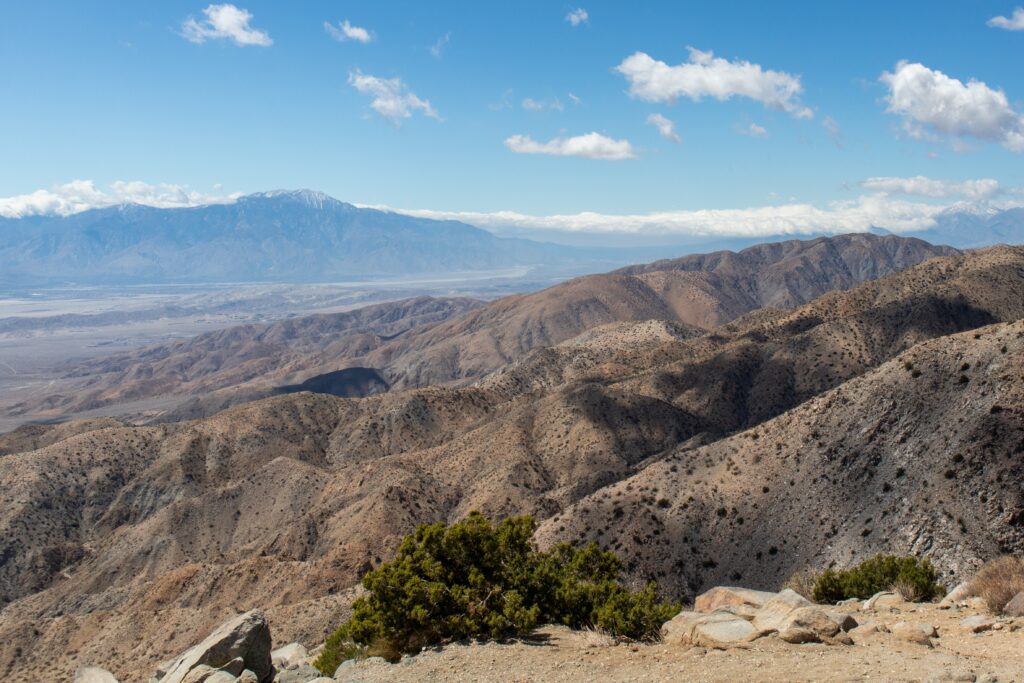
The final stop in your Joshua Tree itinerary is Keys View, which is about a 15-minute drive from the Barker Dam parking lot. There’s a short paved loop path right off the parking lot, which is just about a quarter-mile long.
Keys View is the highest viewpoint in Joshua Tree, and offers sweeping views of the Coachella Valley and the surrounding mountains. On a clear day, you’ll be able to spot the Salton Sea on the far left. Since this viewpoint faces west, it’s a perfect spot to enjoy the sunset on your final day in Joshua Tree.
What to Do with More Time in Joshua Tree
There’s plenty more that you can do in the area if you have additional time. Here are a couple more hikes that you can check out in the park, as well as additional things to do in the area.
Get in More Hiking in Joshua Tree National Park
If you want to spend more time hiking, you have plenty of excellent trails to check out. Lost Palms Oasis Trail – which is located in the southern section of the park – is an ideal choice for anyone looking to do a longer trek. This 7.5-mile out-and-back trail has an elevation gain of just over 1,000 feet, and leads to a palm tree oasis that you can scramble down some rocks to get to.
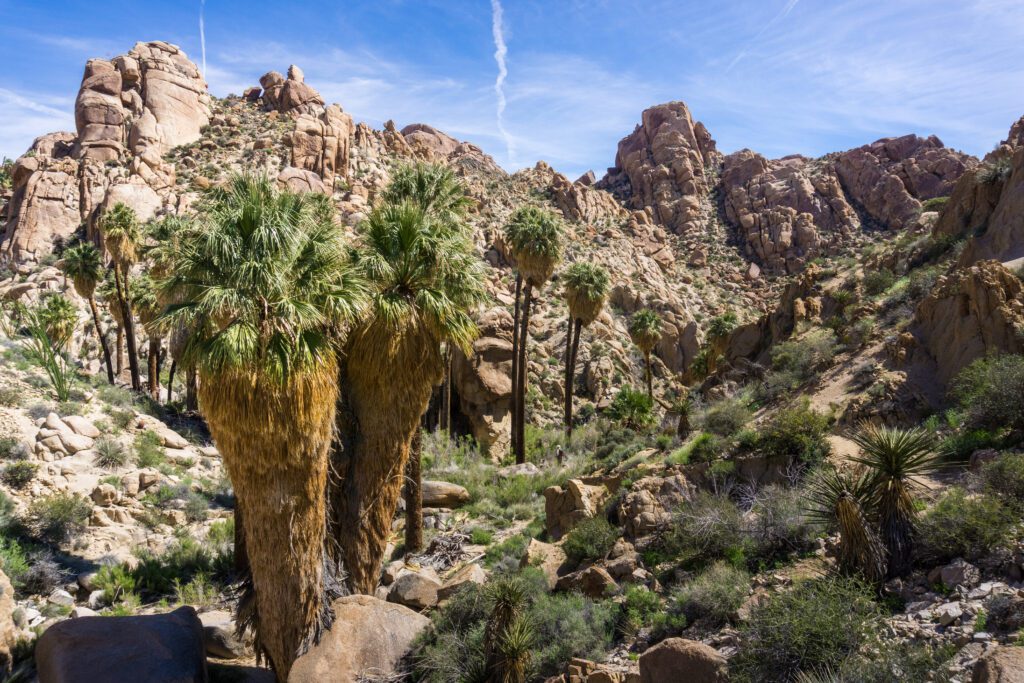
Another shorter option located in the northeast section of the park is Fortynine Palms Oasis Trail. It’s a 3-mile out-and-back trail with a 636-foot elevation gain. It also leads down to a beautiful palm tree oasis.
Explore the Town of Joshua Tree
While it may not be a huge town, Joshua Tree has some pretty fun hidden (and not so hidden) gems that are worth checking out if you have some extra time. We’ll cover a few places to eat and drink below, but there are also two museums worth highlighting.
One is the super tiny and very eclectic World Famous Crochet Museum. This colorful museum (which is located in a converted drive-through photo stand – seriously, it’s tiny!) is home to a huge collection of crochet animals. It’s always open, and there’s a suggested donation of 25 cents.
Another unique (and free) spot is the Noah Purifoy Outdoor Desert Art Museum. Noah Purifoy was a visual artist and sculptor, and this outdoor museum features installations and sculptures he made using recycled material. It’s just about a 10-minute drive from the main street of Joshua Tree.
Visit Pioneertown
About a 20-minute drive west of the town of Joshua Tree, you’ll find Pioneertown. This town was built in 1946 as an old west film set, and over 50 films and TV shows were filmed there in the 1940s and 1950s.
Today, Pioneertown is still regularly used as a film set, but visitors can also stroll the old west town and take photos in front of the false storefronts. There are also a few real shops in town, as well as spots to eat and drink – I’ll mention a couple below.
What to Do with Less Time in Joshua Tree
If you only have a day (or less) to spend in Joshua Tree, you can still see a lot of the park. In fact, we have an entire guide to planning a day trip to Joshua Tree, which has everything you need to know to plan a single day in the park.
If you have a full day in the park, I’d recommend starting with Hidden Valley Nature Trail, and then checking out Jumbo Rocks.
Next, hike the Split Rock Loop Trail, and follow that up with Arch Rock Nature Trail.
End the day at Cholla Cactus Garden, and then if you’d like, grab dinner in town.
Read more: How to Plan an Amazing Day Trip to Joshua Tree National Park
Eating and Drinking near Joshua Tree
For an area that can feel relatively isolated at times, there’s an impressive variety of excellent places to eat and drink all around the greater Joshua Tree area.
In addition to the spots mentioned in the itinerary, here are a few places that I recommend checking out:
La Copine: This trendy brunch and lunch spot in Flamingo Heights (about a 20-minute drive from the town of Joshua Tree) is easily one of the most popular restaurants in the area – so expect to wait for a table if you don’t have a reservation! The menu changes seasonally, but expect to find dishes like duck confit, a lamb and wagyu beef burger, ceviche, and kippered salmon.
The Dez: The Dez is located right in Joshua Tree, and is the perfect spot for grabbing a quick and healthy to-go sandwich to bring into the park to enjoy for lunch. Sandwich options include a BLT, roast beef, turkey swiss, and a vegan chickpea wrap. They also have a full coffee bar.
Roadrunner Grab + Go: This is another spot I recommend stopping by in the morning to grab lunch to bring into the park. Roadrunner offers sandwiches, salads, snacks, drinks, and other pre-made items. They also have some breakfast items, as well as charcuterie boxes with meats and cheeses.
Frontier Cafe: Frontier is an excellent Yucca Valley breakfast and lunch spot. Menu items include a breakfast sandwich, a lox bagel, a tuna melt, a vegan BLT, and more. They also serve to-go coffee and tea drinks.
Pappy + Harriet’s: If you make your way to Pioneertown, you absolutely have to stop by this lively old west-style bar and grill. Enjoy burgers, hot dogs, ribs, sandwiches, salads, and more. They also serve beer, wine, and cocktails, and frequently have live music.
The Red Dog Saloon: Another Pioneertown staple worth checking out is The Red Dog Saloon, which will transport you back to the wild west. In addition to beer, cider, and cocktails, this saloon offers a few great food options, including tacos, quesadillas, elote, and a variety of other shareable snacks. They also serve breakfast on the weekend.
What is the Best Time to Visit Joshua Tree?
There are definitely some seasons that are much more suitable than others for visiting Joshua Tree.
Here’s what you can expect during each season in the area:
Summer: I’d highly advise against visiting Joshua Tree in the summer, as the weather is just too uncomfortably hot, especially for hiking and being outside (in largely unshaded areas) all day long. You can expect temperatures to range from the mid 90s into the 100s – and sometimes even higher.
Fall: While you’ll still get hotter weather in the 90s in the early fall, the later fall is a great time to visit. In October, the average weather tends to hover around the low 80s, and then drops to the high 60s in November. During the evenings, be prepared for weather in the 40s and 50s.
Winter: The winter is also a nice time to visit Joshua Tree, as average temperatures during the daytime tend to range from the high 50s to low 60s. That said, the weather continues to cool down during the evenings, with temperatures dropping into the 30s. Bring layers, and come prepared if you’re camping. While not super common, you should keep in mind that it does occasionally snow in the winter in Joshua Tree.
Spring: The spring is definitely the most popular time to visit Joshua Tree. The early spring in particular is great, as the average temperature is typically in the 70s – perfect for spending the day outside! It does tend to start to get into the 80s during the later spring, which isn’t unbearable, but definitely something to consider if you aren’t great with heat. While still cool, the nighttime average temperatures do start to warm up a bit. You can expect average temperatures in the 40s and low 50s during the evenings.
Learn More: The Best Time to Visit Joshua Tree National Park
How to Get to Joshua Tree National Park
If you’re traveling to Joshua Tree and exploring the park, you absolutely need a car.
There really isn’t a way around it, as there isn’t any sort of shuttle or transportation service within the park, and it’s too spread out to just walk in. With this in mind, here are the options you have for getting to and from Joshua Tree.
From L.A.
For those coming in from Los Angeles, the best (and only) bet is driving.
The drive from Downtown Los Angeles to the town of Joshua Tree will be about two and a half to three hours, depending on traffic. You can take Highway 10 east until you hit Highway 62 (also known as Twentynine Palms Highway), which will take you right into Joshua Tree.
If you’re visiting Joshua Tree for the weekend, I’d recommend either trying to leave Los Angeles earlier in the day on Friday (before 3:00 pm at the very latest) or later in the evening (around 7:30 pm or later) to avoid rush hour traffic. Alternatively, just head out bright and early Saturday morning.
From Elsewhere
If you’re visiting Joshua Tree from elsewhere, you can fly into one of the southern California airports, rent a car, and then drive to Joshua Tree.
The closest airport is Palm Springs International Airport (PSP), which is just about a 50-minute drive from Joshua Tree. It’s a decent-sized airport, with non-stop flights from over 30 airports around the US and Canada.
If you aren’t able to find a good flight option to Palm Springs, I’d recommend trying to fly into Ontario International Airport (ONT), Hollywood Burbank Airport (BUR), or Los Angeles International Airport (LAX). ONT is about an hour and a half away, BUR is about two and a half hours away, and LAX is about three hours away.
You Might Also Like
- JOSHUA TREE: How to Plan an Amazing Day Trip to Joshua Tree National Park
- JOSHUA TREE: Where to Stay near Joshua Tree National Park
- JOSHUA TREE: 12 Stunning Hikes in Joshua Tree National Park
- JOSHUA TREE: The Best Time to Visit Joshua Tree National Park (+ the Worst Time)
- PALM SPRINGS: How to Spend an Amazing Weekend in Palm Springs
- DEATH VALLEY: How to Plan an Incredible Death Valley Itinerary (3 Days)



